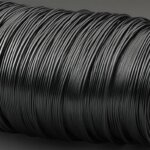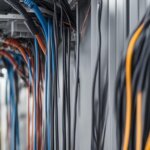Table of Contents
Coaxial cable plays a vital role in modern technology, with a wide range of uses that contribute to our interconnected world. With its ability to efficiently transmit high-frequency electrical signals, coaxial cable has become an indispensable component in various applications.
Coaxial cable is widely used in telephone trunk lines, providing a reliable and clear connection for communication. Additionally, it plays a crucial role in broadband internet networking, ensuring fast and stable data transfer. Whether it’s streaming videos or conducting online meetings, coaxial cable enables seamless connectivity.
Another significant use of coaxial cable is in cable television systems, delivering high-quality audio and video signals to our screens. It serves as the backbone of cable TV infrastructure, allowing us to enjoy a wide range of channels and on-demand content.
Furthermore, coaxial cable serves as the connecting link between radio transmitters and receivers and their antennas. It ensures efficient signal transmission, enabling us to receive clear radio broadcasts and stay connected to our favorite stations.
With its versatility and reliability, coaxial cable has become an essential part of our communication systems, making it possible for audio, video, and data signals to reach us seamlessly.
Whether you’re making a phone call, browsing the internet, watching TV, or listening to the radio, there’s a high chance that coaxial cable is involved, quietly ensuring the smooth flow of information behind the scenes.
Construction and Components of Coaxial Cable
Coaxial cable is a critical component in modern technology, providing reliable transmission of audio, video, and data signals. Its construction involves various components that work together to ensure durability and performance.
The center conductor is a key element of coaxial cable. Typically made of copper-clad steel, it provides the main pathway for signal transmission. To prevent moisture migration, a clean stripping polymer surrounds the center conductor, enhancing its longevity and stability.
The dielectric material is another vital component. It serves two purposes: mechanical stability and insulation. Commonly made of polyethylene or closed-cell foam, the dielectric provides a barrier between the center conductor and outer conductor, ensuring proper signal isolation and minimizing interference.
The outer conductor plays a crucial role in shielding the signal from external interference. It can be made of aluminum-polymer-aluminum tape or aluminum braid, offering high-frequency (HF) shield isolation. In extreme radio frequency (RF) noise environments, an additional outer conductor may be added to further enhance shield isolation.
To protect the cable from environmental factors, a UV-stable outerS jacket is used. Usually made of polyethylene or flame retardant polyvinyl chloride (PVC), the jacket provides insulation and safeguards the cable’s internal components from damage.
These components work synergistically to ensure the efficient transmission of high-frequency signals, making coaxial cable a versatile and reliable choice for various applications in modern technology.
Applications and Advantages of Coaxial Cable
Coaxial cable plays a vital role in a wide range of industries and settings, offering diverse applications and notable advantages. As a transmission line for radio frequency signals, coaxial cable is extensively used in various communication systems, ensuring reliable and efficient signal transmission.
One of the primary applications of coaxial cable is in telephone trunk lines, where it facilitates the transmission of voice and data signals over long distances. Coaxial cable is also widely utilized for broadband internet networking, providing high-speed connectivity for businesses and residential users alike.
Cable television signals heavily rely on coaxial cable as well, delivering a wide range of channels and ensuring excellent signal quality. This makes coaxial cable a crucial component of modern television broadcasting and distribution systems.
Moreover, in the realm of communication systems, coaxial cable is employed to connect radio transmitters and receivers to antennas. This enables efficient and reliable communication for various applications, such as radio broadcasting, wireless networking, and public safety systems.
Coaxial cable offers several distinct advantages over other types of transmission lines. One notable advantage is its precise conductor spacing, which allows for efficient signal transmission with minimal power losses. The design of coaxial cable ensures that the electromagnetic field remains confined to the space between the inner and outer conductors, providing protection from external interference.
Coaxial cable stands out for its ease of installation and durability, making it a preferred choice for communication systems. Its robust construction and reliable performance make it suitable for a wide range of applications, from small-scale residential installations to large-scale telecommunications networks.
Advantages of Coaxial Cable:
- Precise conductor spacing for efficient signal transmission
- Electromagnetic field confinement for protection against interference
- Easy installation and durability
- Wide range of applications in communication systems
Coaxial cable’s versatility and reliability make it an indispensable component for efficient transmission in communication systems. Its applications in telephone lines, broadband internet networks, television signals, and connecting radio transmitters and receivers highlight its crucial role in modern technology.
Choosing the Right Coaxial Cable for Your Needs
When deciding between coaxial cable and fiber optic cable, several factors should be taken into consideration. Fiber optic cables are well-suited for long-distance signal transmission, capable of carrying a significant amount of data without the need for signal repeaters. On the other hand, coaxial cables are better suited for shorter distances and medium-capacity data transfer networks.
While fiber optic cables offer higher and faster data transfer rates, they also come at a higher cost. Coaxial cables, on the other hand, are more commonly found in residential and consumer settings due to their ease of installation and lower cost. It is important to carefully weigh the options based on various factors, including the distance of the connection and the amount of data to be transmitted.
Your decision will ultimately depend on the specific requirements of your project. If you need to transmit data over long distances and have a high-volume data transfer, fiber optic cables would be the ideal choice. However, if you are dealing with shorter distances and require medium-capacity data transfer with a more cost-effective solution, coaxial cables may be the better option.
FAQ
What are the essential uses of coaxial cable in modern technology?
Coaxial cable is used in telephone trunk lines, broadband internet networking cables, high-speed computer data busses, cable television signals, and connecting radio transmitters and receivers to their antennas. It provides reliable transmission of audio, video, and data signals.
What are the components of coaxial cable?
Coaxial cable consists of a center conductor made of copper-clad steel, a dielectric insulation made of polyethylene or closed-cell foam, an outer conductor made of aluminum-polymer-aluminum tape or aluminum braid, and a protective outer jacket made of polyethylene or flame retardant polyvinyl chloride (PVC).
What are the applications and advantages of coaxial cable?
Coaxial cable is commonly used as a transmission line for radio frequency signals, making it ideal for telephone trunk lines, broadband internet networking cables, cable television signals, and connecting radio transmitters and receivers to their antennas. It offers efficient signal transmission with minimal power losses and provides protection from external interference. Coaxial cable is also known for its ease of installation and durability.
How do I choose the right coaxial cable for my needs?
When choosing between coaxial cable and fiber optic cable, consider factors such as the distance of the connection and the amount of data to be transmitted. Fiber optic cables are suitable for long-distance signal transmission and high-capacity data transfer but come at a higher cost. Coaxial cables are best suited for shorter distances and medium-capacity data transfer networks. Evaluate your specific requirements before making a decision.












